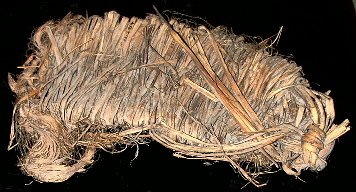

Prehistoric inhabitants of the Chihuahuan Desert could walk for miles on top of plants, their feet never touching the ground. Not the desert you know? Probably because I'm playing with your mind a bit. The statement is literally true, but involves trickery. The plants we're talking about are those used to construct sandals.
Sandals go way back in prehistory, and in the New World, likely were used from earliest times (sandals from a cave in Missouri have been dated at some 8,000 years ago). Sandals have a number of things going for them. In the Chihuahuan Desert, raw materials for manufacture are common. Leaves of various hard succulents, especially yuccas, provided the raw material. The pristine leaf material, cut into strips, often served, but liberated leaf fibers resulted in a more comfortable and versatile footwear.
Sandals were woven in a large variety of styles, rivaling or surpassing
the range seen today. Although less durable than modern goods, nonetheless these
sandals had several advantages: light weight for carrying spares and, in case of
necessity, easy construction on the spot.

Contributor: Arthur H. Harris, Laboratory for Environmental Biology, Centennial Museum, University of Texas at El Paso.
Desert Diary is a joint production of the Centennial Museum and KTEP National Public Radio at the University of Texas at El Paso.

A sandal from the Centennial Museum Collections.